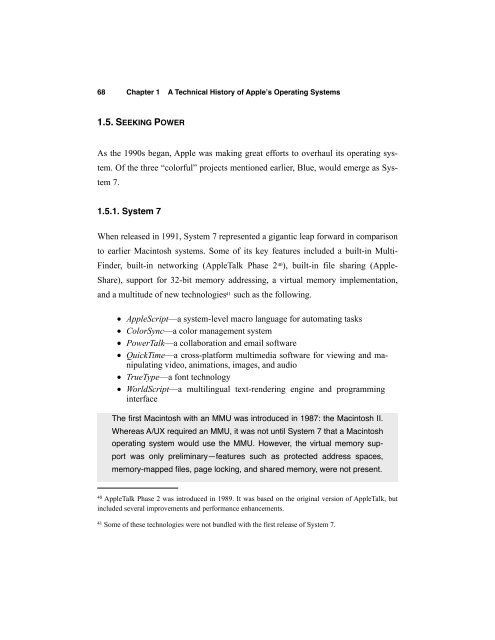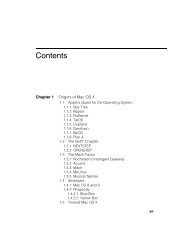A Technical History of Apple's Operating Systems - Mac OS X Internals
A Technical History of Apple's Operating Systems - Mac OS X Internals
A Technical History of Apple's Operating Systems - Mac OS X Internals
Create successful ePaper yourself
Turn your PDF publications into a flip-book with our unique Google optimized e-Paper software.
68 Chapter 1 A <strong>Technical</strong> <strong>History</strong> <strong>of</strong> Apple’s <strong>Operating</strong> <strong>Systems</strong><br />
1.5. SEEKING POWER<br />
As the 1990s began, Apple was making great efforts to overhaul its operating sys-<br />
tem. Of the three “colorful” projects mentioned earlier, Blue, would emerge as Sys-<br />
tem 7.<br />
1.5.1. System 7<br />
When released in 1991, System 7 represented a gigantic leap forward in comparison<br />
to earlier <strong>Mac</strong>intosh systems. Some <strong>of</strong> its key features included a built-in Multi-<br />
Finder, built-in networking (AppleTalk Phase 2 40), built-in file sharing (Apple-<br />
Share), support for 32-bit memory addressing, a virtual memory implementation,<br />
and a multitude <strong>of</strong> new technologies 41 such as the following.<br />
• AppleScript—a system-level macro language for automating tasks<br />
• ColorSync—a color management system<br />
• PowerTalk—a collaboration and email s<strong>of</strong>tware<br />
• QuickTime—a cross-platform multimedia s<strong>of</strong>tware for viewing and manipulating<br />
video, animations, images, and audio<br />
• TrueType—a font technology<br />
• WorldScript—a multilingual text-rendering engine and programming<br />
interface<br />
The first <strong>Mac</strong>intosh with an MMU was introduced in 1987: the <strong>Mac</strong>intosh II.<br />
Whereas A/UX required an MMU, it was not until System 7 that a <strong>Mac</strong>intosh<br />
operating system would use the MMU. However, the virtual memory sup-<br />
port was only preliminary—features such as protected address spaces,<br />
memory-mapped files, page locking, and shared memory, were not present.<br />
40 AppleTalk Phase 2 was introduced in 1989. It was based on the original version <strong>of</strong> AppleTalk, but<br />
included several improvements and performance enhancements.<br />
41 Some <strong>of</strong> these technologies were not bundled with the first release <strong>of</strong> System 7.




